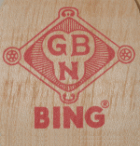About Gebr BING
Gebr BING designs, manufactures, and sells classic teddy bears, dolls, trains and toys.
Early History
Ignaz and Adolf Bing founded Gebrüder Bing in Nürnberg, Germany in 1865 as a tin and kitchenware manufacturer.
Around 1890 the company began making enameled toys. In 1907 Gebrüder Bing made their first bears, joining the teddy
bear revolution at its height. To distinguish their bears, Gebrüder Bing used a metal arrow in the bear’s ear, with
the initials G.B.N. set in a diamond. Later the tag was moved from the ear to under the arm. Around 1920 a metal
label attached to the right arm replaced the tag. Because of Bing’s background in mechanics, it was natural that
they became famous for their mechanical bears and toys. They ranged from bobbing-head bears to walkers, climbers,
and skaters.
From 1905 to 1909 Gebrüder Bing was the “Greatest Toy Producer in the World,” employing over 6,000 skilled workers.
After Ignaz Bing died in 1918, his son Stephan took the reigns of the company. The next year Gebrüder Bing Nürnberg
was renamed Bing-Werke. The company was very successful in the toy industry, but in 1927 the family started to
separate themselves from the business. With the company in arrears by 1932, all of Bing’s tools and machinery went
up for auction.
BING Revival
German businessman Eric Kluge has been at the helm of the Bing revival. He was brought up from the very beginning
in the toy business. Bamberger Puppenwerkstätte, his parents shop, had to be operated solely by his mother during
World War II. His father was drafted into the German Army, leaving his mom as the shopkeeper.
The core of the business during the war was the doll clinic. There were no toys available from 1939 until well after
the war. Only ten years old when his dad was drafted, Eric helped his mother repair dolls that came to the shop. The
time just before Christmas would bring the most work. The most common repair was restringing, with elastic or rubber
bands. Supplies were very limited.
Eric and his wife Margot took over the doll business in 1958. This clinic provided a great resource for both antique
dolls and teddy bears. This experience is what led Eric and Margot to ultimately get involved with the Bing Revival.
Another lady would play a prominent role in the revival of Bing. Mrs. Herman Weidlich, (wife of a BING bear designer)
came to Eric and Margot Kluge's doll shop, the Bamberger Puppenklinik. She commissioned them to sell some of her antique
dolls, which actually belonged to her daughter, Hilde. When these dolls were brought to them, Eric was completely
unaware of the background of the Weidlichs. It was years later, when Eric met the descendants of the Weidlich family
in the United States, that the truth dawned. "As we talked, I started to remember an encounter with an elderly
Bamberg customer whose last name was also Weidlich. She had brought an old doll to be sold," explained Eric. Upon
his return to Germany, he learned the lady had died. He located her daughter, Hilde Weidlich- Dittkowski. Hilde
supported the Bing Company and shared paintings, drawings and countless stories about her father, Herman Weidlich,
and her grandfather, Kunz Weidlich. She consented to allow the use of these resources as the Bing company saw fit.
Borrowing from some of the past, the myriad of offerings which have been produced by the new “Bing" show the company's
genuine effort to revive quality, not quantity! Enjoy the products and experience some of the newly created Bings.
-- Excerpted from BING Bears and Toys by Ken Yenke

